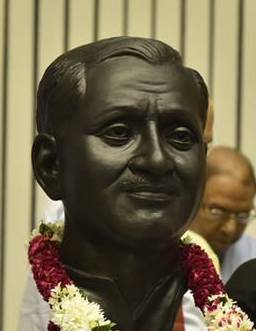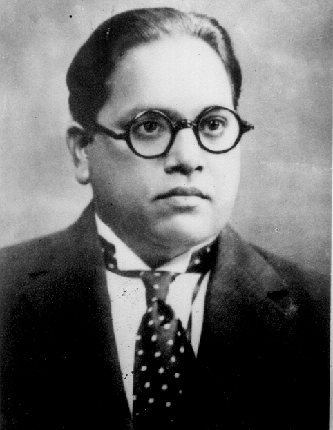|
Dattopant Thengadi
Dattopant Bapurao Thengadi, (Marathi: दत्तोपंत ठेंगडी, 1920–2004) was an Indian Hindu Ideologue, trade union leader and founder of the Swadeshi Jagaran Manch, Bharatiya Mazdoor Sangh and the Bharatiya Kisan Sangh. He is one of the foremost ideologues of Swadeshi economics. He was born in the village of Arvi in Wardha district in Maharashtra. Thengadi was a full-time Rashtriya Swayamsevak Sangh ''pracharak'' until his death on 14 October 2004. The kind of impact he left on the social and economic life of India was unique, and set the tone for generations to come. He has been one of the foremost advocates of the hallmark qualities of his lifestyle: simple living, in-depth study, deep thinking, clarity of thought, courage of the conviction and missionary zeal for the goal. He was awarded with Padma Bhushan but refused to accept it. Early history Dattopant Thengadi (Dattatreya Bapurao Thengadi) was born in the village of Arvi (Wardha, Maharashtra ... [...More Info...] [...Related Items...] OR: [Wikipedia] [Google] [Baidu] |
Arvi, Wardha
Arvi is a city and municipal council in Wardha district in the state of Maharashtra, India. Geography Arvi is located at . It has an average elevation of 328 metres (1075 feet). Arvi is an important centre for the cotton and soybean trade. The closest airport from Arvi is Nagpur Airport situated at 100 kilometres and the closest Railway Station From Arvi is Pulgoan Junction situated at 35 kilometres.The location of Arvi is on Ravandev Garmasur Plateau, which is also a reason for the growth of long thread bearing cotton. Wardha river and Bakli river flowing alongside the borders of Arvi taluka are the main source of water for the villages. Arvi is also called the City of Saints. Saint Maybai, Saint Pandurang Maharaj, Saint Lahanuji Maharaj(Takarkheda) are the prominent ones having their own followers spread across the Vidarbha region. Demographics India census, Arvi had a population of 42,822: 21,956 males (51%) and 20,864 females (49%). There are 5,836 members of ... [...More Info...] [...Related Items...] OR: [Wikipedia] [Google] [Baidu] |
Deepawali
Diwali (), Dewali, Divali, or Deepavali (IAST: ''dīpāvalī''), also known as the Festival of Lights, related to Jain Diwali, Bandi Chhor Divas, Tihar, Swanti, Sohrai, and Bandna, is a religious celebration in Indian religions. It is one of the most important festivals within Hinduism where it generally lasts five days (or six in some regions of India), and is celebrated during the Hindu lunisolar months of Ashvin (according to the amanta tradition) and Kartika (between mid-October and mid-November).''The New Oxford Dictionary of English'' (1998) – p. 540 "Diwali /dɪwɑːli/ (also Diwali) noun a Hindu festival with lights...". It is a post-harvest festival celebrating the bounty following the arrival of the monsoon in the subcontinent. Diwali symbolises the spiritual "victory of light over darkness, good over evil, and knowledge over ignorance".Jean Mead, ''How and why Do Hindus Celebrate Divali?'', The festival is widely associated with Lakshmi,Suzanne Barchers ... [...More Info...] [...Related Items...] OR: [Wikipedia] [Google] [Baidu] |
Hindu Dharma
Hinduism () is an Indian religion or ''dharma'', a religious and universal order or way of life by which followers abide. As a religion, it is the world's third-largest, with over 1.2–1.35 billion followers, or 15–16% of the global population, known as Hindus. The word ''Hindu'' is an exonym, and while Hinduism has been called the oldest religion in the world, many practitioners refer to their religion as '' Sanātana Dharma'' ( sa, सनातन धर्म, lit='the Eternal Dharma'), a modern usage, which refers to the idea that its origins lie beyond human history, as revealed in the Hindu texts. Another endonym is ''Vaidika dharma'', the dharma related to the Vedas. Hinduism is a diverse system of thought marked by a range of philosophies and shared concepts, rituals, cosmological systems, pilgrimage sites, and shared textual sources that discuss theology, metaphysics, mythology, Vedic yajna, yoga, agamic rituals, and temple building, among other topics. Promi ... [...More Info...] [...Related Items...] OR: [Wikipedia] [Google] [Baidu] |
Deendayal Upadhyaya
Pandit Deendayal Upadhyaya (25 September 1916 – 11 February 1968) was an Indian politician, proponent of integral humanism ideology and leader of the political party Bharatiya Jana Sangh (BJS), the forerunner of Bharatiya Janata Party (BJP). Upadhyaya started the monthly publication ''Rashtra Dharma'', broadly meaning 'National Duty', in the 1940s to spread the ideology of Hindutva nationalism. Upadhyaya is known for drafting Jan Sangh's official political doctrine, ''Integral humanism'', by including some cultural-nationalism values and selectively appropriating few Gandhian socialist principles such as sarvodaya (progress of all) and swadeshi (self-sufficiency). Early life He was brought up in a Brahmin family by his maternal uncle. His education, under the guardianship of his maternal uncle and aunt, saw him attend high school in Sikar. The Maharaja of Sikar gave him a gold medal, Rs 250 to buy books and a monthly scholarship of Rs 10. and did his Intermediate in Pil ... [...More Info...] [...Related Items...] OR: [Wikipedia] [Google] [Baidu] |
Bhimrao Ramji Ambedkar
Bhimrao Ramji Ambedkar (14 April 1891 – 6 December 1956) was an Indian jurist, economist, social reformer and political leader who headed the committee drafting the Constitution of India from the Constituent Assembly debates, served as Law and Justice minister in the first cabinet of Jawaharlal Nehru, and inspired the Dalit Buddhist movement after renouncing Hinduism. Ambedkar graduated from Elphinstone College, University of Bombay, and studied economics at Columbia University and the London School of Economics, receiving doctorates in 1927 and 1923 respectively and was among a handful of Indian students to have done so at either institution in the 1920s. He also trained in the law at Gray's Inn, London. In his early career, he was an economist, professor, and lawyer. His later life was marked by his political activities; he became involved in campaigning and negotiations for India's independence, publishing journals, advocating political rights and social freedo ... [...More Info...] [...Related Items...] OR: [Wikipedia] [Google] [Baidu] |
Madhav Sadashiv Golwalkar
Madhav Sadashivrao Golwalkar (19 February 1906 – 5 June 1973), popularly known as Guruji was the second '' Sarsanghchalak'' ("Chief") of the Rashtriya Swayamsevak Sangh (RSS). Golwalkar is considered one of the most influential and prominent figures among Rashtriya Swayamsevak Sangh. He was the first person to put forward the concept of a cultural nation called "Hindu Rashtra" which is believed to have evolved into the concept of the "Akhand Bharat Theory", united nations for Bharatiyas. Golwalkar was one of the early Hindu nationalist thinkers in India. Golwalkar authored the book ''We, or Our Nationhood Defined''. ''Bunch of Thoughts'' is a compilation of his speeches. Early life Golwalkar was born to Sadashivrao and Lakshmibai Golwalkar in a Marathi Karhade Brahmin family at Ramtek, near Nagpur in Maharashtra. His family was prosperous and supported him in his studies and activities. Sadashivrao, a former clerk in the Posts and Telegraphs Department, became a teacher in t ... [...More Info...] [...Related Items...] OR: [Wikipedia] [Google] [Baidu] |
Communist Party Of India
Communist Party of India (CPI) is the oldest Marxist–Leninist communist party in India and one of the nine national parties in the country. The CPI was founded in modern-day Kanpur (formerly known as Cawnpore) on 26 December 1925. History Formation The Communist Party of India was formed on 26 December 1925 at the first Party Conference in Kanpur, which was then known as ''Cawnpore''. Its founders included M. N. Roy, his wife Evelyn Trent, Abani Mukherji, and M. P. T. Acharya. S.V. Ghate was the first General Secretary of CPI. There were many communist groups formed by Indians with the help of foreigners in different parts of the world, Tashkent group of Contacts were made with Anushilan and Jugantar the groups in Bengal, and small communist groups were formed in Bombay (led by S.A. Dange), Madras (led by Singaravelu Chettiar), United Provinces (led by Shaukat Usmani), Punjab, Sindh (led by Ghulam Hussain) and Bengal (led by Muzaffar Ahmed). Involvement in ... [...More Info...] [...Related Items...] OR: [Wikipedia] [Google] [Baidu] |
Indian National Trade Union Congress
Indian National Trade Union Congress (INTUC) is a national trade union in India. It was founded on 3 May 1947 and is affiliated with the International Trade Union Confederation. According to provisional statistics from the Ministry of Labour, INTUC had a membership of 33.95 million in 2013, making it the largest Trade Union in India. Early years The foundation of INTUC on 3 May 1947 just 3 months before India attained independence. Acharya JB Kripalani, who was then President of the Indian National Congress inaugurated the Founding conference of INTUC. Among the distinguished leaders who attended the opening session were Pandit Jawaharlal Nehru, Shankarrao Deo, Jagjivan Ram, B. G. Kher, OP Mehtab, Aruna Asaf Ali, Ram Manohar Lohia, Ashoka Mehta, Ramchandra Sakharam Ruikar, Maniben Patel and other prominent trade unionists. Under the guidance of Mahatma Gandhi, the founding fathers in their wisdom preferred to let the INTUC have an independent identity with its own constit ... [...More Info...] [...Related Items...] OR: [Wikipedia] [Google] [Baidu] |
Hindustan Socialist Republican Association
Hindustan Socialist Republican Association (HSRA), previously known as the Hindustan Republican Army and Hindustan Republican Association (HRA), was an Indian revolutionary organisation founded by Ram Prasad Bismil, Ashfaqulla Khan, Sachindra Nath Bakshi, Sachindranath Sanyal and Jogesh Chandra Chatterjee. HRA's written constitution and published manifesto, titled ''The Revolutionary'', were produced as evidence in the Kakori conspiracy case of 1925. Origins Background The Non-cooperation movement of 1919 led to large scale mobilisation of Indian population against the British Raj. Though intended as a Nonviolent resistance movement, it soon turned violent. After the Chauri Chaura incident, Mahatma Gandhi suspended the movement to prevent the escalation of violence. This disillusioned a section of nationalists who felt the suspension was premature and unwarranted. The political vacuum created by the suspension led to the formation of revolutionary movements by the more radic ... [...More Info...] [...Related Items...] OR: [Wikipedia] [Google] [Baidu] |





